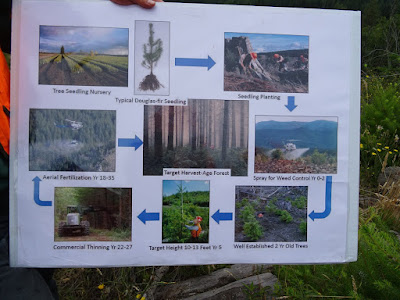Date of Visit: August 9, 2019
Type of event: Study tour
Topic: Industrial Forest Management
Organization: Weyerhauser Company
Location: Mount St Helens, Skamania County, Washington
Hosts: Molly Rasor /Inventory Forester, Mark Sheldahl / Forester
International Fellows: Richard Banda (Malawi), Fen-hui Chen (Taiwan), Temitope Dauda (Nigeria), Zhongyuan Ding (China), Will Maiden (United Kingdom), Romain Matile (France), Rodolfo Vieto (Costa Rica)
WFI Staff: Shadia Duery / International Fellowship Program Manager
Weyerhaeuser Company is one of the world's largest private owners of timberlands, owning or controlling nearly 12.4 million acres of timberlands in the U.S. and managing an additional 14 million acres of timberlands under long-term licenses in Canada. In 1904, after years of successful Mississippi River-based lumber and mill operations, Frederick Weyerhaeuser moved west and founded the Weyerhaeuser Timber Company. The Homestead Act contributed significantly to the successful story of the Weyerhaeuser Company. Frederick Weyerhauser was able to secure many land properties from forest landowners, which had earlier been procured from the government as part of its contribution to economic development in the Pacific Northwest. In 1929, the company built what was then the largest sawmill in the world in Longview, Washington.
Location: Mount St Helens, Skamania County, Washington
Hosts: Molly Rasor /Inventory Forester, Mark Sheldahl / Forester
International Fellows: Richard Banda (Malawi), Fen-hui Chen (Taiwan), Temitope Dauda (Nigeria), Zhongyuan Ding (China), Will Maiden (United Kingdom), Romain Matile (France), Rodolfo Vieto (Costa Rica)
WFI Staff: Shadia Duery / International Fellowship Program Manager
 |
| WFI International Fellows with Weyerhauser hosts (in center), Mark Sheldahl and Molly Rasor |
Weyerhaeuser Company is one of the world's largest private owners of timberlands, owning or controlling nearly 12.4 million acres of timberlands in the U.S. and managing an additional 14 million acres of timberlands under long-term licenses in Canada. In 1904, after years of successful Mississippi River-based lumber and mill operations, Frederick Weyerhaeuser moved west and founded the Weyerhaeuser Timber Company. The Homestead Act contributed significantly to the successful story of the Weyerhaeuser Company. Frederick Weyerhauser was able to secure many land properties from forest landowners, which had earlier been procured from the government as part of its contribution to economic development in the Pacific Northwest. In 1929, the company built what was then the largest sawmill in the world in Longview, Washington.
The company's operations are divided into three major business segments:
1. Timberlands—growing and harvesting trees in renewable cycles.
2. Wood products—manufacturing and distribution of building materials for houses and other structures.
3. Real estate, energy and natural resources—all surface and subsurface resources in timberlands that are worth more than the timber itself.
 |
| Our hosts explaining their work in a second-growth Douglas fir stand |
All of Weyerhaeuser’s operations on timberland comply with state and federal laws on management and conservation. Weyerhaeuser manages its forests intensively to get the most yield in such a way that does not compromise future wood supply while protecting other resources on their land, such as elk, salmon, and so on. Many considerations are taken regarding biodiversity, water quality, and other ecosystem services. The tree species planted depend on site suitability as Weyerhauser’s objective is to maximize each site’s productivity for its economic returns. On their timberland in Washington state, Douglas Fir is the dominant “tree crop”. Another indicator of the company’s sustainable forest management practices is the provision of recreational opportunities to the public. Weyerhaeuser sells permits to the public allowing access to camp, hunt, and other recreational purposes on their land. Native American tribes are also allowed to collect some food on Weyerhaeuser land like fish, huckleberries, etc. Weyerhaeuser runs its own nursery to meet their seedling demand and also supplies to other landowners. They also have a seed orchard which is a repository of their surplus trees.
At Weyerhaeuser, harvesting is a pre-planned operation. Usually, harvest planning starts five years before actual operations. An inventory is conducted to check the volume of wood available on potential sites. Harvesting operation starts with delineating the boundaries of the plot to be harvested followed by water stream typing into fishing or non-fishing, and perennial or seasonal. A 25-foot buffer is created along non-fishing streams, while 50-foot buffers are created along fishing streams. When all this on-ground work is done and certified by the company’s forest managers, they proceed to submit their intended operation to the state forestry department for review, which takes about 30 days, after which recommended adjustment are made and harvest takes place.
One of the recurring lessons we have seen over the past few months is that old-growth forest contains a higher density of wood than secondary forest, and this is again seen on Weyerhaeuser forest land. Although Weyerhaeuser is the largest private timber owner in the world, it has not stopped improving. It is constantly looking for better ways to increase its income, maximize profit, and manage sustainable forest. It has made us realize that instead of thinking ”I have made it, and I am the best”, we should ask ourselves ”How can I do better?’
International Fellows’ Thoughts and Perspectives
As a century-old company, the long-term success of Weyerhaeuser is dependent on a healthy, sustainable supply of resources (e.g. trees) and well-performing, long-term management. Usually, the term “sustainable forest management” is more theoretical than practical but Weyerhaeuser has proven that their business is sustainable indeed. For example, irrespective of the timber market trends, they maintain a 2% annual harvest on their timberlands and follow their long–term harvest plan. At present, the third generation Douglas-fir seedlings are planted on-site.
Weyerhaeuser is very holistic in its management. Its management comprises a tree seedling nursery, a seedling plantation, herbicide spraying for weed control, commercial thinning, aerial fertilization, and planned harvesting. Decisions such as when should a tract be fertilized, thinned, pruned, and harvested are based on a wide range of operational systems, such as a tree breeding system, a GIS-based inventory system, a 3-year-circle checking system, a wood stock selecting system, and so on.

No comments:
Post a Comment